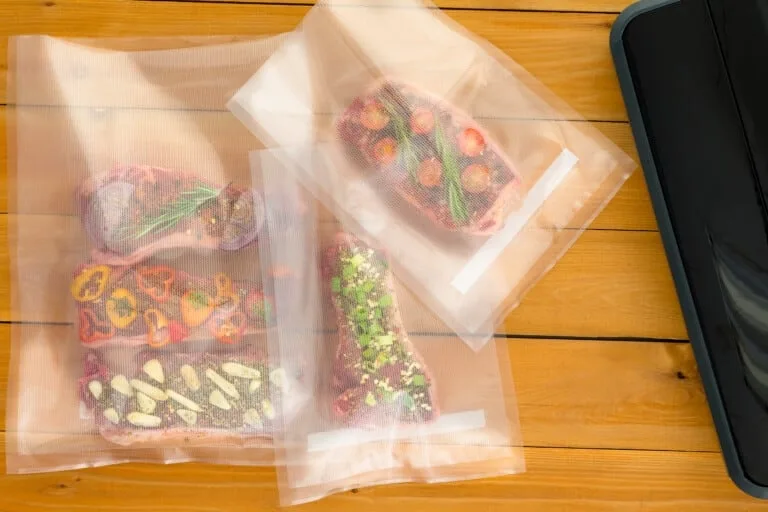How to Pack Liquid with a Vacuum Sealer? - Pdf Slider

How to pack liquid with a vacuum sealer?
Food vacuum packing is an innovative practice, which allows the good preservation of foodstuffs, sometimes for years.
For this, a sealing machine is used, which, by external suction, removes all the air from the vacuum bags where the foodstuffs to be packaged are placed.
Deprived of oxygen, food does not undergo rapid deterioration or the proliferation of micro-organisms, which is linked to time.
All types of food can be vacuum sealed, but what about liquids? How to pack liquid with a vacuum sealer?
We explain everything in this article!
By the way, why use a vacuum sealer?
A vacuum machine (or vacuum device, or "food saver") is a kitchen appliance made of plastic or stainless steel, which was previously found in many places in the catering sector, but is also being used in individuals.
It extends the shelf life of fresh or cooked food in vacuum bags, hermetically sealed.
Entirely deprived of oxygen, the foodstuffs are protected from the ambient air and the development of bacteria, leading to the rapid decomposition of food.
In general, vacuum-packed foods last 5 times longer, and almost all of their minerals and vitamins are retained.
Very practical and economical, the vacuum preservation system avoids food waste and allows you to prepare good meals in advance while having the possibility of facilitating the storage and storage of your food for years.

Can you pack liquid with a vacuum sealer?
Good news! It is quite possible to vacuum liquid foods, soups, juices, and dishes in sauce to increase their preservation time, provided you use a vacuum chamber machine or an external suction machine with special vacuum boxes.
With a vacuum chamber machine
It is the most delicate step, as the sealer may pick up liquid after all the air has been sucked out, potentially resulting in contamination. We give you some tips to make the vacuum packing process easier:
- Always wait until liquid products are cold before vacuum packing them to respect the cold chain. It also avoids thermal shocks related to the temperature difference (which could overheat the motor pump), prevents steam formation, and avoids any projection (a cold liquid is denser and more compact, it flows less easily than a hot liquid).
- Please pay attention to the dimensions of the bags: they must be long and bulky enough not to break under pressure and avoid overflowing.
- Do not vacuum seal too much liquid, but rather divide them into several small individual portions. Storage will be easier, and potential incidents at the time of sealing will be avoided.
- Be careful not to dirty the part of the bag where the sealing bar will be; otherwise, it will not close properly.
- Use the vacuum sealer on a flat, straight work surface to facilitate the operation.
With a suction vacuum sealer with cans
This method is the easiest to perform because it requires less manipulation and is less delicate. In addition, the boxes are a perfect solution for your fragile liquid products to be vacuum-sealed: storage is made easier. It wastes greatly reduced since you do not use vacuum bags but reusable containers that are dishwasher safe. So how to proceed?
- First, you need a vacuum sealer with external suction and a suction pipe (or manual suction pump);
- Check that the containers, their seals, and lids are clean and dry;
- Place your preparations in the container, adding the lid without the pressure handles (do not close it);
- Screw the suction pipe onto the valve located on the lid;
- Remove the air from the container by activating the pump several times, until you feel resistance (between 5 and 10 times approximately), and close the lid by lowering the handles;
- To open the container, press the lid valve to release the air (you will hear a sound), and remove the handles. That's it!
You can completely put your containers in the microwave; however, you must open the valve on the lid to let the air out beforehand.
If the air is not released, the action of the microwave can deform or even break your container.
For optimal conservation, we recommend that you always refrigerate your containers well.
This type of storage with boxes is ideal for people who want to do without plastic, with the different kinds of embossed and smooth bags usually found.
And you no longer need to buy, and there are vacuum sealers specially designed for glass jars and cans. Awesome, right?
The benefits of vacuum packing
To cook sous vide
This type of cooking consists of plunging your sous vide bag into a large pot of water brought to the boil, thus obtaining a nice even cooking.
All vitamins and minerals are retained, and you cook with very little fat.
The dream, right? And you can also make vacuum marinades, where the taste of the products will be much more interesting over time.
For storing all types of food
Dry foods (fish, seafood, meats, vegetables, fruits, etc.) or liquids (meals in sauce, juices, soups, etc.)
The vacuum sealer is a versatile device that never limits you in format or texture to be packaged.
If you choose the right size bags and keep your food well in the fridge, vacuum storage makes your life easier!
For very long preservation of your food
Once vacuum sealed, your food can freeze and thus benefit from an even longer shelf life.
For example, some frozen dry products can last 2 to 3 years!
Deprived of air, they are much easier to store in your fridges and freezers and are less likely to degrade quickly.
All nutritional values are retained, so don't wait any longer!
What you must remember
- The vacuum packing of liquids (meals in sauce, soups, juices, broth, etc.) is quite possible, provided that certain hygiene rules are respected and the right equipment is used;
- The vacuum sealer with external suction + suction pipe is more practical to pack liquids: solid containers are used rather than plastic vacuum bags for packaging;
YOU MAY ALSO LIKE
5 Woodworking Tips For Beginners
Here are 5 top tips to follow as a woodworker who is just getting started on a new hobby or business. Following these tips will give you a great foundation to get started! Following these simple steps to start your woodworking adventure will not only give you a great foundation to start each project but also for building your new business or hobby. And as always, remember to follow all safety procedures and to abide by the manufacturer’s recommendations for each tool you use.
Most Important Things About Curtains You Should Not Miss Out
Thinking of decorating your house with curtains but not getting out of the pandemic situation? Don't know what to do so? Your thoughts are over? Lairing window is one of the efficient ways to add visual interest to the space while giving you privacy or light control. But the question comes about how to layer your window treatment because it isn't as simple as it seems.
Choosing a Bedroom Wall Mirror
Mirrors are a beautiful and functional accent in any room, and there are many styles and types to choose from. You can choose a mirror with a floral motif, tree branch frame, or fleur-de-lis pattern to add a whimsical touch to your room. Mirrors are also available in panel, oval, and rectangle shapes.
Similar Links
Different types of Bedroom Furniture
The bedroom is the most intimate part of a house and so it is always the priority of the home owners to keep their bedroom as clean and as trendy as possible.
Similar PDFs
Raymond Ten X Habitat Thane
Raymond Ten X Habitat offers 1 BHK and 2 BHK Flats in various apartments located in Pokhran Road 2 in Thane and it is designed by Raymond Group. Visit: https://www.raymondtenxhabitatthane.in/
Hiranandani Estate Thane
Hiranandani Estate Thane offers 1 BHK to 3 BHK apartments with wonderful amenities in Thane at resonable cost. Hiranandani Group has launched this balanced housing project in Thane, Mumbai. For More information... Visit: https://www.hiranandaniestatethane.ind.in/
5 Best Electric Pressure Cooker USA 2022
In this article we’ll break down the Top 5 Best Electric Pressure Cooker available in the USA market, comparing them for features versus performance. Cooking rice the traditional method on a regular basis might be tedious.







